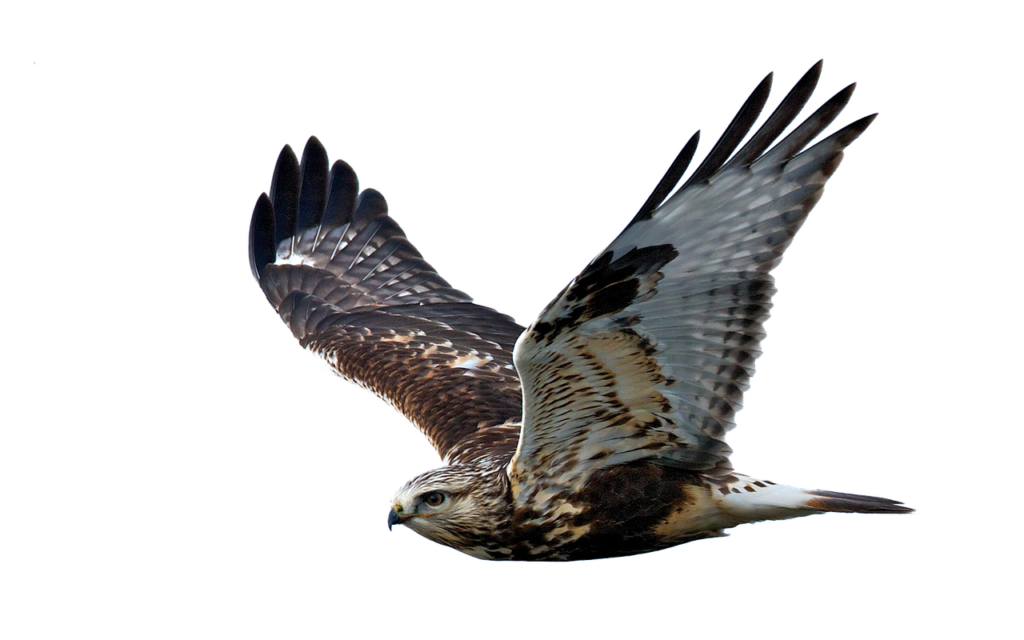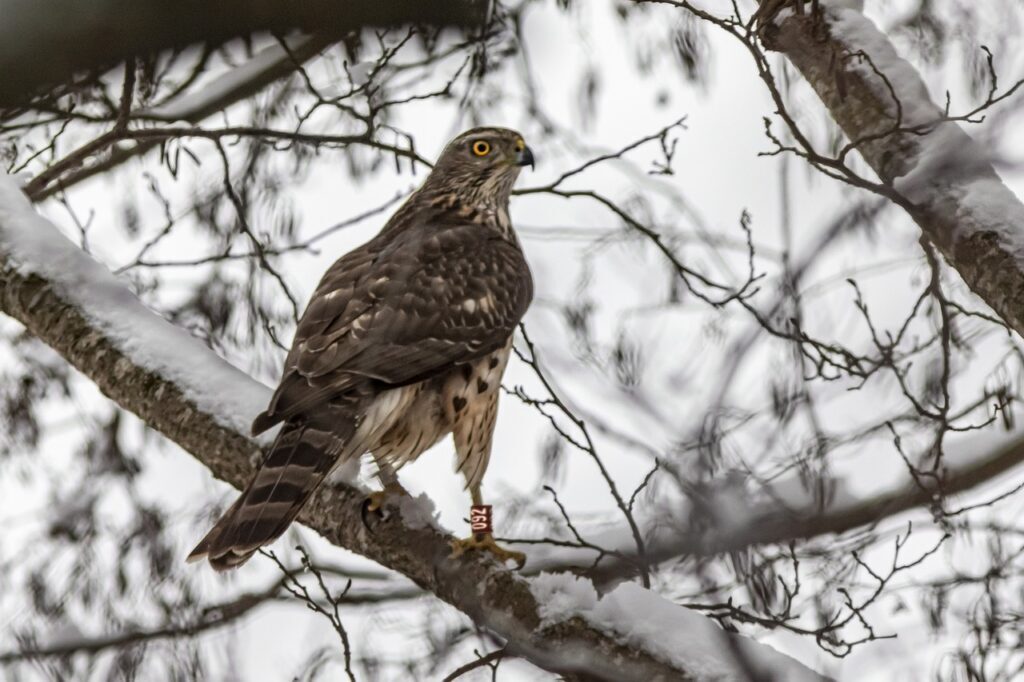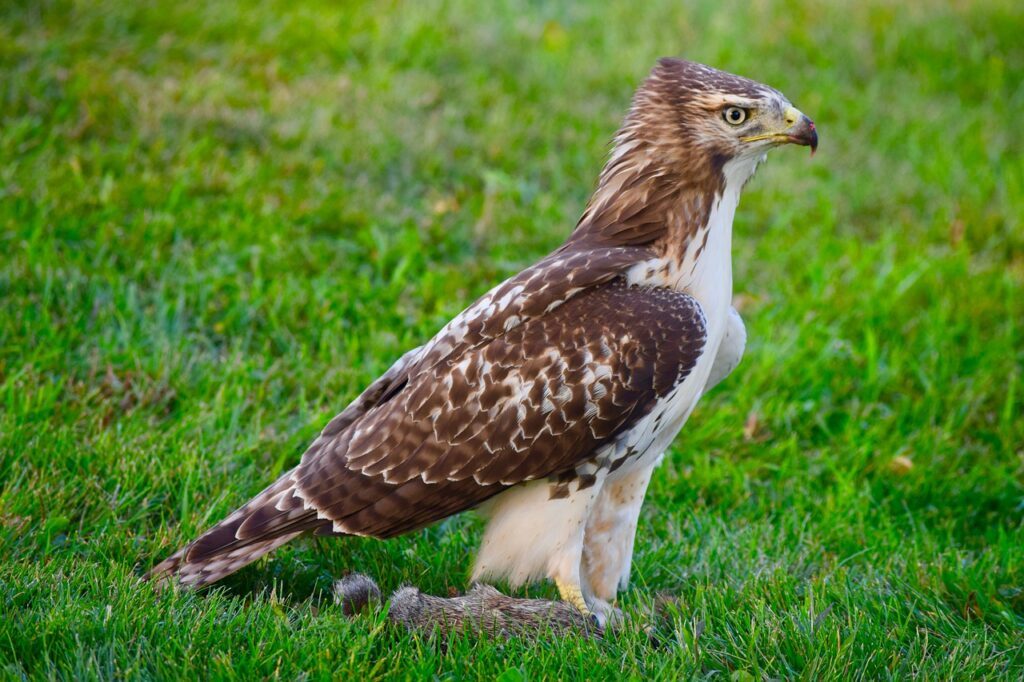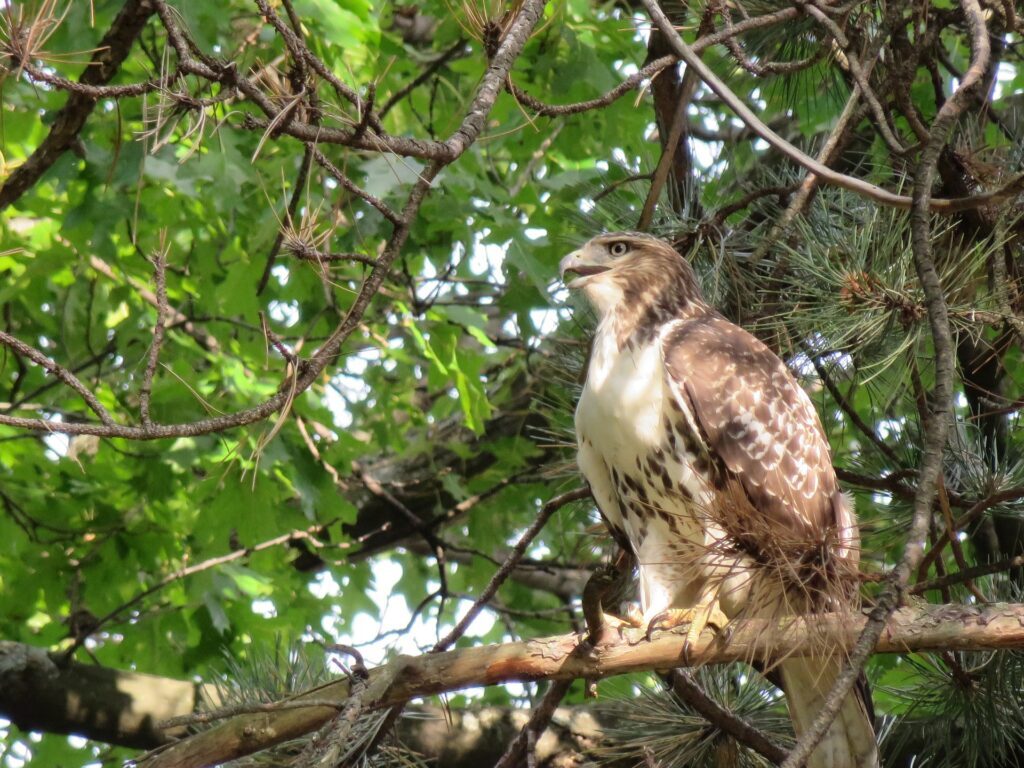From the mountains to the sea, discover hawks in North Carolina. If you visit North Carolina, chances are that you will see Hawks.
From their small stature to their bellowing cry, learn about the 9 species of hawks in NC and how you can spot them along your journey.
High altitude, open fields and woodlands are the most common habitats for hawks. The Carolinas have a variety of hawks and there are several places for viewing Hawks in North Carolina during all seasons.
“What kind of hawk is that?” That is a question you may hear people ask as an Osprey, red-tailed hawk, or other raptor flies by. And since North Carolina has lots of diverse kinds of habitat, it does not surprise us that our state has many kinds of hawks.
 hawks-in North carolina
hawks-in North carolina
Species Of Hawks in North Carolina
Every year, visiting birdwatchers and bird photographers flock to North Carolina to observe its rich biodiversity.
Hawks are well known for their beautiful aerial flight maneuvers, which is why many local people and tourists make it a point to go trekking in the woods just so they could be able to see one of these majestic creatures up close.
In fact, with so many gorgeous species of hawks in NC, you would think it is difficult to differentiate between them. It is not, though, and we will give you some tips on how to do this below. Here is the list of species of hawks in North Carolina:
- Red-shouldered Hawk
- Cooper’s Hawk
- Sharp-shinned Hawks
- Northern Goshawk
- Red-tailed Hawk
- Broad-winged Hawk
- Northern Harrier
- Rough-legged Hawks
- Osprey
1. Red-Shouldered Hawk
 red-shouldered-hawks in north carolina
red-shouldered-hawks in north carolina
If you are looking to identify a red-shouldered Hawk, you are sure to see one. Just try to remember that Native Americans believed red-shouldered Hawks were the “messengers of the gods. “If you want to spot this variety, you will be traveling to an area near a water source such as a river, swamp, or lake.
The red-shouldered hawk is a beautifully colored bird of prey with distinctive reddish colors on the back and breast. Its brown eyes are large.
Males range between 43 and 58 cm (15 – 23 inches) in length, and females are usually larger than males at 46 to 61 cm (19 – 24 inches). The red-shouldered hawk is one of the most common hawks to be found in eastern North America, southern Canada, and the northwestern United States.
They have excellent vision and amazing sense of hearing, with deadly talons that can kill animals as big as them. They eat frogs, lizards, amphibians, snakes and mammals. They lay two to five bluish or white eggs and often reuse their nest each year.
You can find red-shouldered hawks all year round in every part of North Carolina. If you care to know how it sounds, check this.
2. Cooper’s Hawk
 coopers_hawks in north carolina
coopers_hawks in north carolina
The Cooper’s Hawk is a medium-sized hawk. It is a bit larger than the Sharp-shinned Hawk. Its male’s length is between 14.6 to 15.3 inches (37 to 39 cm) while the female is between 16.5 to 17.7 inches (42 to 45 cm)
As an adult, it has a blue-gray back, red-and-orange breast, and dark bands on the tail. Adult Cooper’s Hawks have a bigger head that projects well beyond the wings and they fly with a strong, undulating flight.
Some of the best backyard birders have been startled by Cooper’s hawk suddenly attacking their feeders.
They may look like they are dropping out of nowhere, but they are stealthy so, watch your back! Cooper’s hawks can fly at super speeds and zigzag through the treetops in search of prey. They may find your backyard a great spot for hunting.
Cooper’s Hawk is a fearless predator that hunts like an eagle. Living in woodlands across North America, their gorgeous, black-and-grey plumage is a perfect match for their habitat.
Cooper’s Hawk is known for its graceful, long-winged profile and its vociferous call. It is an extremely adaptable bird capable of living in almost all open habitats, from prairie to forest.
In addition to hunting small mammals, Cooper’s hawk also feeds on other birds and large insects. Cooper’s Hawk builds a large stick nest high in a tree. They lay two to six eggs that are bluish-white to pale blue.
3. Sharp-shinned Hawk
 sharp-shinned-hawk-
sharp-shinned-hawk-
The Sharp-shinned Hawk can be seen in North Carolina in winter. They are rare and are in less than two percent of bird sightings in North Carolina.
This hawk is the smallest hawk in North Carolina. Though they are slightly bigger than blue jay, they are smaller than a crow. Their females are a third larger than their males.
The Sharp-shinned Hawk is a small hawk, weighing only 3.1 – 7.7 oz, with a wingspan of 16.9 – 22.1 inches.
These birds usually have feathers that blend in well with the forest where they live. They are highly active and can speed all the way through dense woods to catch their prey in flight, usually songbirds. Therefore, they are called ‘’pursuit hunters.”
Sharp-shinned Hawks grab their target on a stump or low branch before eating it. They usually eat songbirds that are of the same size as robins. They also eat other small birds, frogs, large insects, snakes, lizards, rodents, bats and squirrels.
4. Northern Goshawk
 northern-goshawk-
northern-goshawk-
While we certainly cannot say that the North American Goshawk is one of the most beautiful birds that we know, there is at least one reason to go out into the wilderness just to see this creature up close.
If you locate one of its nests, which are generally quite easy to spot because they are usually big, you will be able to see one of the most impressive constructions that a bird has ever created.
These nests are known for being particularly big, strong and works of art, something that you may find largely due to the big and powerful birds that create them.
The Northern Goshawk tends to be a reclusive bird that does not seem to like being around people. Through the years, a few have been spotted in North Carolina and are often mistaken for a Pigeon Hawk or Cooper’s Hawk.
They are, in fact, one of the largest raptors found in North America. Along with their size, they are known for their long tails and distinctive call. Not wanting to be found, however, is the best strategy for survival.
The truth of the matter is that you would be better off visiting a real sanctuary, where you may be able to see this magnificent bird. Better still, you may have to look for areas where large trees meet the open woodlands.
5. Red-tailed Hawk
 red-tailed-hawk-
red-tailed-hawk-
The red-tailed hawk, also known as the ‘chicken hawk,’ is primarily a bird of prey, but it is not common in North Carolina because they mostly feed on rodents.
To get food, they hunt during the day, prowling low over fields and through forests to strike prey from behind trees or swooping down from high perches or soaring overhead to capture their prey.
This raptor can survive in many habitats as long as it has an ample food supply. The red-tailed hawk is found across North America, most frequently in wooded areas with open space.
The ultimate, perfect couple, Red-tailed Hawks perform an amazing sky dance when wooing each other to make them mates for life. They have also been seen hunting together, working as a unit to catch rodents such as squirrels from a tree.
When it comes to spotting hawks, there is no better place than North Carolina. The Red-Tailed Hawk migration occurs during winter, but the birds can be found in NC year-round.
6. Broad-winged Hawk
 Broad-winged Hawk
Broad-winged Hawk
Broad-winged hawks are stocky birds with a medium-length tail, dark backs and a pale bar on the underside of their tails. These hawks have an intricate, varied diet that includes toads, frogs and small mammals.
They also eat insects, animals, and reptiles such as snakes and lizards. Broad-winged hawks are predators at the top of their food chain. They have an energy cost of great for hunting their prey and an energy gain is poor for digesting their food.
Hawks that consume a variety of animals have longer lifespans than hawks that eat a specialty diet, such as only rodents or only fish. This is due to the times in between meals and the fact that prey animals move around more frequently.
Broad-winged hawks spend their breeding season in NC and then migrate to South America for the winter. They play a big part in making hawk-watching amazing.
If you are interested in watching these birds, use binoculars to watch them hunt. You will be able to see the expression on their faces as they stoop like an arrow toward their prey, which often have no idea what is coming at them until it is too late.
7. Northern Harrier
 northern-harrier-
northern-harrier-
Not every bird that is beautiful is also smart. But the Northern Harrier has both brains and looks; for this reason, it soars above a wide variety of grassy fields, truly making its mark as one of the most aesthetically pleasing birds to grace North American skies.
Northern Harriers live in a wide range of habitats, from dense forests and open fields to desert canyons. Their populations are large, so successfully protecting them is a big priority for most organizations.
The Northern Harrier is a swift, acrobatic hunter of small animals in an open country. It possesses the ability to hear tiny sounds at great distances, locate prey with its acute vision, and then swoop down in a spectacular dive to capture prey in talons that can exert tremendous pressure on small animals.
With their length of 18.1-19.7 in (46-50 cm) and a wingspan of 40.2-46.5 in (102-118 cm), they are one of the biggest birds you want to see whenever you visit North Carolina.
8. Rough-legged Hawks
 Rough-legged_Hawk
Rough-legged_Hawk
Although Rough-legged Hawks are common in the winter, they are less common in North Carolina due to the southern edge of their range. Rough-legged Hawks usually fly overhead and perched on a pole.
They stay close to open fields and marshes while migrating through the state. Populating the Appalachian Mountains, they nest in rugged cliffs and hunt small mammals, reptiles, and insects.
Rough-legged Hawks are northern birds that breed in Canada and the United States during summer and spend the winter along the Pacific coast. They are large hawks, between the size of a goose and a crow.
Their exceptionally large talons give them their name, as they have adapted to life on the ground by walking and running through the snow. The feathered legs help to keep them nice and warm in the arctic.
Rough-legged Hawks are pale gray on the breast with dark bars and a dark cap. Their wings also have dark bars. Adults are distinctive, with long, thickly feathered legs, making them easy to identify.
Rough-legged hawks fly long distances and rarely do they flap in flight. These hawks’ nest in high elevation areas in Alaska, Canada, and northern states such as North Carolina. They usually nest on cliffs or rock scree.
9. Osprey
 Common Hawks” class=”wp-image-691″/> Osprey Most Common Hawks
Common Hawks” class=”wp-image-691″/> Osprey Most Common Hawks
The osprey is North Carolina’s largest native hawk. Did you know that the osprey is no more a hawk? The osprey looks and behaves like its hawk relatives, but ospreys are part of their own unique family of birds.
They are not only massive, but they are also wild and notoriously ferocious as well. They hunt fish by diving bomb-like into lakes and rivers with their razor-sharp talons extended, coming up with writhing fish in their grasp!
Their unique coloring helps keep them camouflaged when they are lying in wait on a tree limb or clinging to a rock.
The fish hawk name is deserved because this bird survives on a diet that is 99 percent fish. They are usually found near ponds, bays, reservoirs, seashores and anywhere they can get fish.
Ospreys do not panic when fish is not readily available to consume. Instead, they adapt, turning to muskrats, insects, lizards and squirrels for sustenance.
Hawks In NC FAQs
What’s The Most Common Winter Hawk In North Carolina?
If you have visited North Carolina and have seen a hawk, that hawk is probably a red-tailed hawk because it is the most common hawk in NC. However, the following hawks are also common:
- Red-shouldered Hawk
- Cooper’s Hawk
- Sharp-shinned Hawks
- Northern Goshawk
- Red-tailed Hawk
- Broad-winged Hawk
- Northern Harrier
- Rough-legged Hawks
- Osprey
How Long Do Hawks Stay in One Area?
Most hawks in North Carolina stay in one area until they cannot use their nest. Science Encyclopedia says, “A pair of red-shouldered hawks and their offspring used the same area for 45 years.”
Can Hawks Pick up Humans?
Since hawks cannot transport preys that outweigh them, it is not possible to pick up humans. They cannot even pick up most adult dogs and cats.
Where Do Hawks Sleep at Night?
Hawks are frequently drawn to trees, so they sleep in their nest on top of towering trees. When there is cold, they are drawn to trees with thick leaves and branches.
What Do Hawks Eat In NC?
Hawks mostly rely on mammals to eat. They eat rats, voles, mice, rabbits, ground squirrels, snakes, carrion, larger birds like blackbirds, pheasants and starlings.
Is It Good to Have a Hawk in Your Yard?
It is good on one hand and bad on the other hand. They make meals out of harmless animals, but they also help you keep away wildlife that is a nuisance such as gophers, rats and snakes. So, you need hawks to keep the balance.
Watch More Most Common Hawks In North Carolina | Video
Conclusion
Hawks in NC are wonderful creatures, and they are a delight to watch. If you are on the search for hawk sightings, keep an eye out for large birds – eagles and hawks have much in common in appearance and habits.
Hawks can be found all over North Carolina– if you live near the coast, then you can easily spot them soaring above beach side dunes, fields and marshes. If you prefer forest habitats, then you can go hiking towards the foothills of the Mountains and try your luck at spotting one of these magnificent birds.
